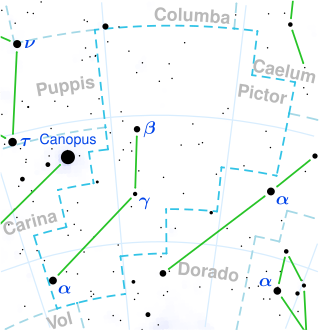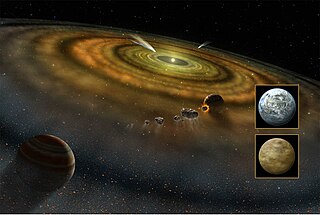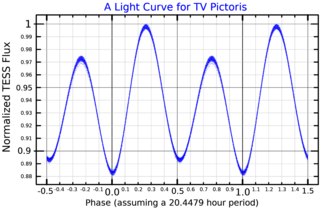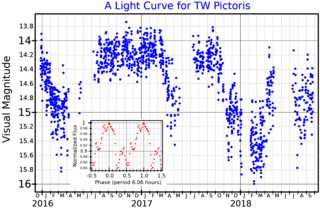
Telescopium is a minor constellation in the southern celestial hemisphere, one of twelve named in the 18th century by French astronomer Nicolas-Louis de Lacaille and one of several depicting scientific instruments. Its name is a Latinized form of the Greek word for telescope. Telescopium was later much reduced in size by Francis Baily and Benjamin Gould.

Pictor is a constellation in the Southern Celestial Hemisphere, located between the star Canopus and the Large Magellanic Cloud. Its name is Latin for painter, and is an abbreviation of the older name Equuleus Pictoris. Normally represented as an easel, Pictor was named by Abbé Nicolas-Louis de Lacaille in the 18th century. The constellation's brightest star is Alpha Pictoris, a white main-sequence star around 97 light-years away from Earth. Pictor also hosts RR Pictoris, a cataclysmic variable star system that flared up as a nova, reaching apparent (visual) magnitude 1.2 in 1925 before fading into obscurity.

Beta Pictoris is the second brightest star in the constellation Pictor. It is located 63.4 light-years (19.4 pc) from the Solar System, and is 1.75 times as massive and 8.7 times as luminous as the Sun. The Beta Pictoris system is very young, only 20 to 26 million years old, although it is already in the main sequence stage of its evolution. Beta Pictoris is the title member of the Beta Pictoris moving group, an association of young stars which share the same motion through space and have the same age.

RR Pictoris, also known as Nova Pictoris 1925, is a cataclysmic variable star system that flared up as a nova that lit up in the constellation Pictor in 1925. It was discovered by South African amateur astronomer R. Watson who lived in Beaufort West. At 05:50 AM on 25 May 1925, Mr. Watson was walking to work and noticed a star that he did not recognize in line with the stars α Crucis and β Carinae. He consulted his copy of Norton's Star Atlas, and realized that the unfamiliar star was a nova. Fortuitously, Mr. Watson was employed as a telegraph operator, and he promptly sent a telegram describing his discovery to the Royal Observatory at Cape Town. This quick reporting of the event allowed southern observatories to obtain spectra of the nova before it had reached maximum brightness.

AB Pictoris is a K-type star, approximately 163 light-years away in the constellation of Pictor. It has been identified as a member of the young Tucana–Horologium association. The star has also been classified as a BY Draconis variable. In 2005 it was announced that an astronomical object had been imaged in 2003 and 2004 close to and apparently in orbit around the star. Its mass suggests that it is at the borderline between being a brown dwarf or a planet.
Theta Pictoris is a star in the Pictor constellation.

Beta Pictoris b (abbreviated as β Pic b) is an exoplanet orbiting the young debris disk A-type main sequence star Beta Pictoris located approximately 63 light-years (19.4 parsecs, or 6×1014 km) away from Earth in the constellation of Pictor. It has a mass around 13 Jupiter masses and a radius around 46% larger than Jupiter's. It orbits at 9 AU from Beta Pictoris, which is about 3.5 times farther than the orbit of Beta Pictoris c. It orbits close to the plane of the debris disk orbiting the star, with a low eccentricity and a period of 20–21 years.
51 Ophiuchi is a single star located approximately 410 light years away from the Sun in the equatorial constellation of Ophiuchus, northwest of the center of the Milky Way. It is visible to the naked eye as a faint, blue-white point of light with an apparent visual magnitude of 4.81. The star is moving closer to the Earth with a heliocentric radial velocity of –12 km/s.

An exocomet, or extrasolar comet, is a comet outside the Solar System, which includes rogue comets and comets that orbit stars other than the Sun. The first exocomets were detected in 1987 around Beta Pictoris, a very young A-type main-sequence star. There are now a total of 27 stars around which exocomets have been observed or suspected.

Gamma Pictoris, Latinised from γ Pictoris, is a single, orange-hued star in the southern constellation of Pictor. It is a faintly visible to the naked eye with an apparent visual magnitude of 4.50. Based upon an annual parallax shift of 18.45 mas as seen from Earth, this star is located about 177 light-years from the Sun. It is moving away from the Sun with a radial velocity of +15.7 km/s.

Delta Pictoris, Latinized from δ Pictoris, is a binary star system in the southern constellation Pictor. It is visible to the naked with a combined apparent visual magnitude of 4.72. The system is located at a distance of approximately 1,300 light years from the Sun based on parallax measurements, and is drifting further away with a radial velocity of ~31 km/s. It is a runaway star system that is generating a bow shock as it moves through the interstellar medium.
η2 Pictoris, Latinised as Eta2 Pictoris, is a solitary star in the southern constellation of Pictor. It is visible to the naked eye as a dim, orange-hued star with an apparent visual magnitude of 5.02. With an annual parallax shift of 7.8 mas as seen from the Earth, it is located around 418 light years from the Sun. It is a member of the HR 1614 moving group of stars that share a common motion through space.

S Pictoris is a Mira variable-type star in the constellation Pictor. It ranges between apparent magnitude 6.5 and 14.0, and spectral types M6.5e to M8III-IIe, over a period of 422 days.

TV Pictoris is a rotating ellipsoidal variable star in the constellation Pictor. It ranges between apparent magnitude 7.37 - 7.53 over a period of 0.85 days. It was first discovered to be variable in 1987. The system is inclined at an angle of 54 degrees to observers on Earth. It is composed of a primary star that has a radius 4.3 times that of the sun and 1.2 times its mass, and an effective (surface) temperature of 8300 K, and a secondary star with a radius 2.1 times that of the sun and 40% of its mass, and an effective temperature of 7000 K. Both stars are less massive than expected for a main sequence star of their temperatures. The secondary rotates much faster than the primary.
AK Pictoris is a star system in the constellation Pictor. Its combined apparent magnitude is 6.182. Based on the system's parallax, it is located 69 light-years away. AK Pictoris is a member of the AB Doradus moving group, a group of stars with similar motions that are thought to be associated.

TW Pictoris is a 14th magnitude cataclysmic variable star system in the southern constellation of Pictor. It is located at a distance of approximately 1,430 light-years based on parallax measurements. Photometric observations in the visual band suggest a binary system with an orbital period of 6.06 hours. One of the components is an accreting white dwarf.
HD 256 is a binary star system in the equatorial constellation of Cetus. It has a white hue and is dimly visible to the naked eye with an apparent visual magnitude of 6.20. Based upon parallax measurements, the system is located at a distance of approximately 474 light years from the Sun. It is drifting closer with a radial velocity of −10 km/s.

AO Mensae is a single variable star in the southern circumpolar constellation of Mensa. It is too faint to be viewed with the naked eye, having an apparent visual magnitude that ranges from 9.96 down to 10.18. The star is 128 light years distant from the Sun based on parallax, and is drifting further away with a radial velocity of +16 km/s. It is a member of the Beta Pictoris moving group, a loose association of young stars moving through the galaxy.
Beta Pictoris c is the second exoplanet discovered orbiting the young star Beta Pictoris, located approximately 63 light-years away from Earth in the constellation of Pictor. Its mass is around nine times that of Jupiter, and it orbits at around 2.7 astronomical units (AU) from Beta Pictoris, about 3.5 times closer to its parent star than Beta Pictoris b. It has an orbital period of 1,200 days. The orbit of Beta Pictoris c is moderately eccentric, with an eccentricity of 0.24.
In astronomy, the Columba association is a nearby 42+6
−4 Myr old stellar association. The association is named after the constellation Columba which contains many of the stars first recognized in the group.











